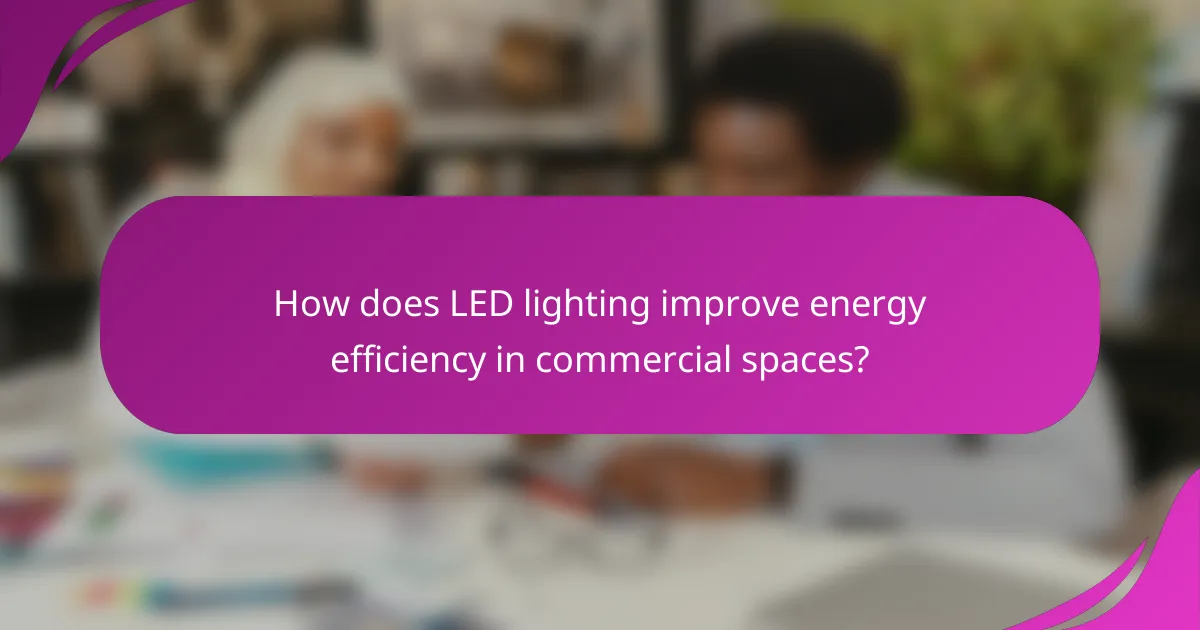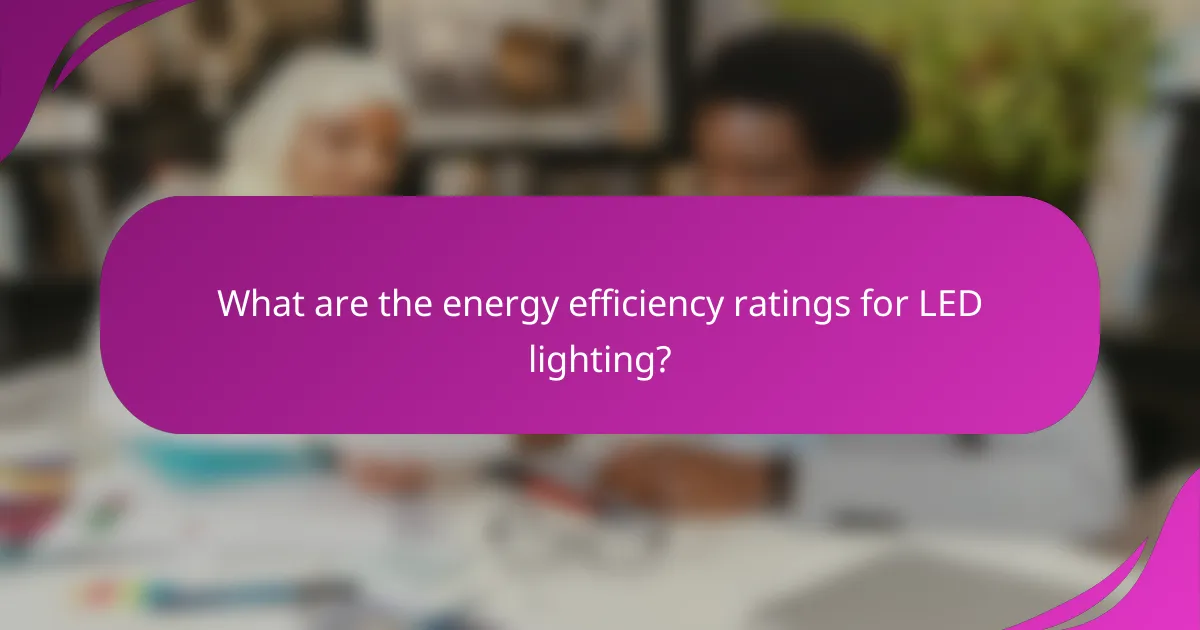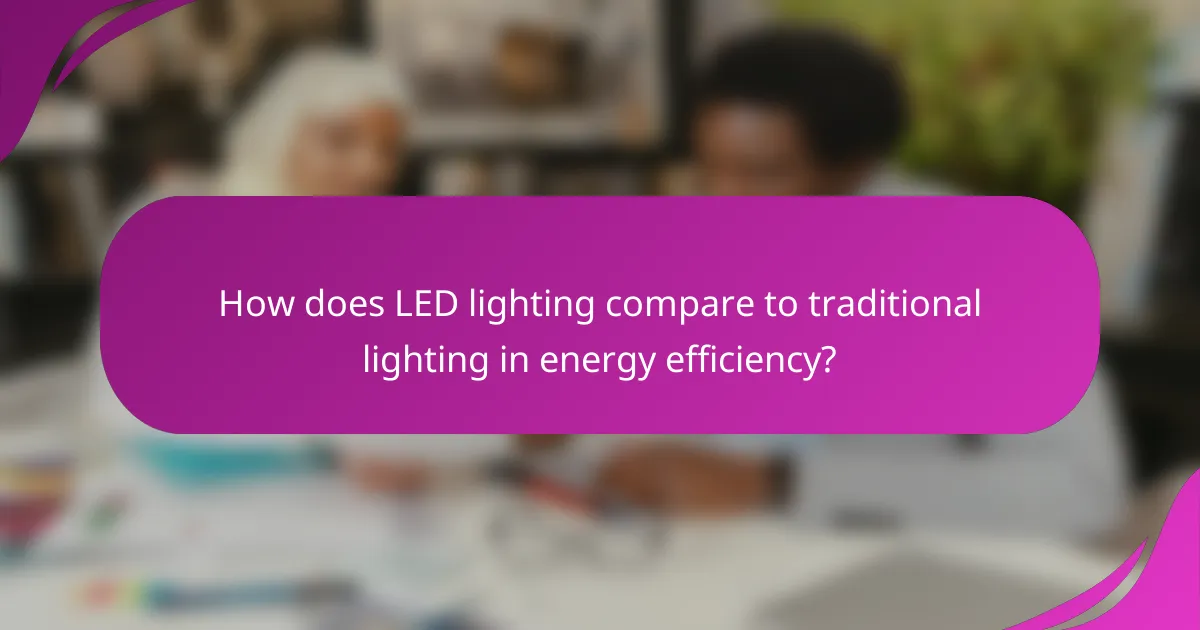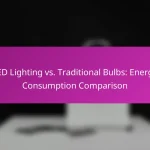LED lighting has revolutionized energy efficiency in commercial spaces by using significantly less electricity while delivering superior illumination. This advancement not only lowers energy consumption but also aids businesses in meeting energy regulations and reducing their carbon footprints.

How does LED lighting improve energy efficiency in commercial spaces?
LED lighting significantly enhances energy efficiency in commercial spaces by consuming less electricity while providing superior illumination. This technology not only reduces overall energy usage but also contributes to lower carbon footprints and compliance with energy regulations.
Reduced energy consumption
LED lights consume up to 80% less energy compared to traditional incandescent bulbs. This reduction in energy consumption translates to lower demand on electrical systems, which is particularly beneficial in large commercial buildings where lighting can account for a significant portion of total energy use.
For example, switching from a standard 60-watt bulb to a 10-watt LED can lead to substantial savings over time, especially when multiplied across numerous fixtures in a facility. Businesses can expect to see a noticeable decrease in their monthly energy bills.
Lower operational costs
With reduced energy consumption comes lower operational costs. LED lighting not only decreases electricity expenses but also minimizes the need for frequent replacements and maintenance. This is crucial for commercial spaces where downtime can lead to lost productivity.
In many cases, businesses can recover their initial investment in LED fixtures within a few years due to these savings. Additionally, some regions offer incentives or rebates for upgrading to energy-efficient lighting, further reducing upfront costs.
Enhanced lighting quality
LED lighting provides superior quality illumination, offering better color rendering and brightness compared to traditional options. This enhanced lighting quality can improve visibility and comfort in commercial environments, which can positively affect employee productivity and customer experience.
Moreover, LEDs can be easily dimmed and controlled, allowing businesses to tailor lighting to specific tasks or moods, further enhancing the overall environment.
Longer lifespan of fixtures
LED fixtures typically have a lifespan of 25,000 to 50,000 hours, significantly outlasting traditional bulbs that may only last 1,000 hours. This longevity means less frequent replacements, which not only saves money but also reduces waste and the environmental impact associated with discarded bulbs.
Businesses can benefit from this durability by scheduling fewer maintenance activities, allowing staff to focus on core operations rather than lighting upkeep. This is particularly advantageous in hard-to-reach areas where changing bulbs can be labor-intensive and costly.

What are the energy efficiency ratings for LED lighting?
Energy efficiency ratings for LED lighting indicate how effectively these lights convert electricity into visible light while minimizing energy waste. These ratings help businesses assess the potential savings on energy costs and the environmental impact of their lighting choices.
Energy Star certification
Energy Star certification is a widely recognized standard that signifies a product meets strict energy efficiency guidelines set by the U.S. Environmental Protection Agency. For LED lighting, this certification ensures that the products use at least 20-30% less energy than standard options, which can lead to significant cost savings over time.
When selecting LED lights, look for the Energy Star label to ensure compliance with these efficiency standards. This not only helps in reducing energy bills but may also qualify businesses for rebates or incentives offered by utility companies.
LEED credits for energy efficiency
LEED (Leadership in Energy and Environmental Design) is a green building certification program that recognizes best-in-class building strategies and practices. Incorporating LED lighting can contribute to earning LEED credits, particularly in the Energy and Atmosphere category, which emphasizes energy performance and efficiency.
To maximize LEED points, businesses should consider using LED fixtures that are Energy Star certified and implement lighting controls such as occupancy sensors and daylight harvesting systems. These measures not only enhance energy efficiency but also improve overall building sustainability and occupant comfort.

How does LED lighting compare to traditional lighting in energy efficiency?
LED lighting significantly outperforms traditional lighting options like incandescent and fluorescent bulbs in energy efficiency. LEDs consume less power while providing the same or greater illumination, leading to lower energy bills and reduced environmental impact.
Energy savings percentage
LED lights can save between 50% to 80% more energy compared to traditional lighting. For instance, switching from incandescent bulbs to LEDs can reduce energy consumption from about 60 watts per bulb to around 10 watts, translating to substantial savings over time.
In commercial spaces, these energy savings can lead to thousands of dollars in reduced electricity costs annually, depending on the scale of the operation and the number of fixtures replaced.
Maintenance cost differences
LED lighting typically has a longer lifespan, often lasting 15,000 to 50,000 hours compared to 1,000 hours for incandescent bulbs. This longevity reduces the frequency of replacements and associated labor costs, making LEDs a more cost-effective option in the long run.
Additionally, the lower heat output of LEDs minimizes cooling costs in commercial spaces, further enhancing their economic benefits. Businesses should consider these factors when evaluating lighting options for energy efficiency and overall cost savings.

What are the key factors influencing energy efficiency ratings in commercial spaces?
The key factors influencing energy efficiency ratings in commercial spaces include building design, the types of LED fixtures used, and the implementation of lighting control systems. Each of these elements plays a crucial role in determining how effectively energy is utilized, impacting overall efficiency ratings.
Building design and layout
Building design and layout significantly affect energy efficiency ratings by influencing how natural light enters and interacts with artificial lighting. For example, spaces with large windows and open layouts can reduce reliance on artificial lighting during daylight hours, thereby improving energy efficiency.
Additionally, strategic placement of LED fixtures can enhance illumination while minimizing energy consumption. Consider using task lighting in areas where focused light is needed, which can help reduce the overall number of fixtures required.
Type of LED fixtures used
The type of LED fixtures selected for a commercial space can greatly impact energy efficiency ratings. High-quality LED fixtures typically consume less energy and have longer lifespans compared to traditional lighting options. Choosing fixtures with a high lumen output per watt can maximize efficiency.
When selecting LED fixtures, consider their color temperature and dimming capabilities. For instance, fixtures with adjustable brightness can adapt to varying occupancy levels, further enhancing energy savings.
Lighting control systems
Lighting control systems are essential for optimizing energy efficiency in commercial spaces. These systems can include timers, occupancy sensors, and daylight harvesting technologies that automatically adjust lighting based on real-time conditions. Implementing these controls can lead to significant reductions in energy usage.
For example, occupancy sensors can turn off lights in unoccupied areas, while daylight harvesting systems can dim artificial lighting when sufficient natural light is available. Investing in advanced lighting controls can improve energy efficiency ratings and reduce operational costs over time.

How can businesses in London benefit from LED lighting?
Businesses in London can significantly enhance their energy efficiency ratings by switching to LED lighting. This transition not only reduces energy consumption but also lowers operational costs and improves overall sustainability.
Compliance with local regulations
LED lighting helps businesses comply with London’s stringent energy efficiency regulations, such as the Energy Act and the London Plan. These regulations encourage the adoption of energy-saving technologies to reduce carbon emissions and promote sustainability.
By using LED lights, businesses can meet or exceed the required energy performance standards, which can lead to fewer inspections and potential fines. It’s essential to stay updated on local regulations to ensure compliance and avoid penalties.
Incentives for energy-efficient upgrades
London offers various incentives for businesses that invest in energy-efficient upgrades, including LED lighting. These can include grants, tax relief, and financing options that make the initial investment more manageable.
For example, the Greater London Authority provides funding programs aimed at supporting energy efficiency improvements. Businesses should explore these opportunities to offset costs and enhance their return on investment when upgrading to LED lighting.

What are the challenges of implementing LED lighting in commercial spaces?
Implementing LED lighting in commercial spaces presents several challenges, including initial costs and compatibility with existing systems. Businesses must carefully evaluate these factors to ensure a successful transition to energy-efficient lighting.
Initial investment costs
The initial investment costs for LED lighting can be significant, often ranging from several hundred to several thousand dollars, depending on the size of the space and the number of fixtures needed. While LED lights are more expensive upfront compared to traditional lighting options, they typically offer long-term savings through reduced energy consumption and longer lifespans.
Businesses should consider potential rebates or incentives from local governments or utility companies, which can help offset these initial costs. Evaluating the return on investment (ROI) over time is crucial, as many organizations see payback periods of a few years due to lower energy bills.
Integration with existing systems
Integrating LED lighting with existing systems can pose challenges, particularly in older commercial buildings. Compatibility issues may arise if the current infrastructure is not designed to support LED technology, which could require additional modifications or upgrades.
To facilitate a smoother transition, businesses should conduct a thorough assessment of their current lighting systems and consult with professionals who specialize in LED installations. Planning for potential disruptions during the upgrade process is essential to minimize downtime and maintain operational efficiency.

What are the emerging trends in LED lighting for commercial spaces?
Emerging trends in LED lighting for commercial spaces focus on energy efficiency, smart technology integration, and sustainable practices. These advancements not only enhance lighting quality but also contribute to significant cost savings and improved environmental impact.
Smart lighting technology
Smart lighting technology incorporates sensors and automation to optimize energy use in commercial environments. This technology allows for features such as occupancy sensing, daylight harvesting, and remote control, which can significantly reduce energy consumption.
Businesses can implement smart lighting systems that adjust brightness based on the presence of people or natural light levels. For example, a conference room can automatically dim lights when no one is present, leading to energy savings of up to 30% in some cases.
When considering smart lighting, it’s essential to evaluate compatibility with existing systems and the potential for integration with building management systems. Investing in a scalable solution can provide long-term benefits as technology evolves.


